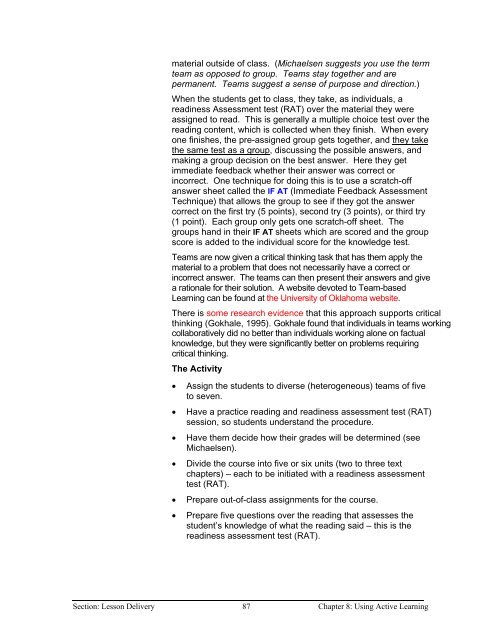Chapter 9 - Instructional Media: Chalkboards to Video - CGISS
Chapter 9 - Instructional Media: Chalkboards to Video - CGISS
Chapter 9 - Instructional Media: Chalkboards to Video - CGISS
Create successful ePaper yourself
Turn your PDF publications into a flip-book with our unique Google optimized e-Paper software.
material outside of class. (Michaelsen suggests you use the term<br />
team as opposed <strong>to</strong> group. Teams stay <strong>to</strong>gether and are<br />
permanent. Teams suggest a sense of purpose and direction.)<br />
When the students get <strong>to</strong> class, they take, as individuals, a<br />
readiness Assessment test (RAT) over the material they were<br />
assigned <strong>to</strong> read. This is generally a multiple choice test over the<br />
reading content, which is collected when they finish. When every<br />
one finishes, the pre-assigned group gets <strong>to</strong>gether, and they take<br />
the same test as a group, discussing the possible answers, and<br />
making a group decision on the best answer. Here they get<br />
immediate feedback whether their answer was correct or<br />
incorrect. One technique for doing this is <strong>to</strong> use a scratch-off<br />
answer sheet called the IF AT (Immediate Feedback Assessment<br />
Technique) that allows the group <strong>to</strong> see if they got the answer<br />
correct on the first try (5 points), second try (3 points), or third try<br />
(1 point). Each group only gets one scratch-off sheet. The<br />
groups hand in their IF AT sheets which are scored and the group<br />
score is added <strong>to</strong> the individual score for the knowledge test.<br />
Teams are now given a critical thinking task that has them apply the<br />
material <strong>to</strong> a problem that does not necessarily have a correct or<br />
incorrect answer. The teams can then present their answers and give<br />
a rationale for their solution. A website devoted <strong>to</strong> Team-based<br />
Learning can be found at the University of Oklahoma website.<br />
There is some research evidence that this approach supports critical<br />
thinking (Gokhale, 1995). Gokhale found that individuals in teams working<br />
collaboratively did no better than individuals working alone on factual<br />
knowledge, but they were significantly better on problems requiring<br />
critical thinking.<br />
The Activity<br />
• Assign the students <strong>to</strong> diverse (heterogeneous) teams of five<br />
<strong>to</strong> seven.<br />
• Have a practice reading and readiness assessment test (RAT)<br />
session, so students understand the procedure.<br />
• Have them decide how their grades will be determined (see<br />
Michaelsen).<br />
• Divide the course in<strong>to</strong> five or six units (two <strong>to</strong> three text<br />
chapters) – each <strong>to</strong> be initiated with a readiness assessment<br />
test (RAT).<br />
• Prepare out-of-class assignments for the course.<br />
• Prepare five questions over the reading that assesses the<br />
student’s knowledge of what the reading said – this is the<br />
readiness assessment test (RAT).<br />
Section: Lesson Delivery 87 <strong>Chapter</strong> 8: Using Active Learning
















